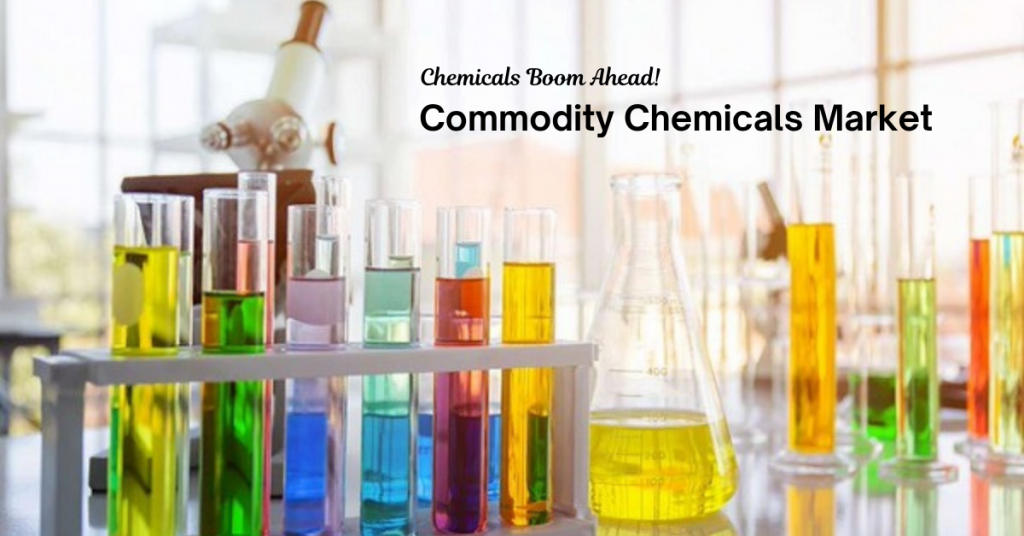
Market Overview
The Commodity Chemicals Market is projected to grow from USD 743,606.06 million in 2024 to USD 1,260,560 million by 2032, registering a CAGR of 6.82% during the forecast period. This consistent expansion underscores the growing relevance of commodity chemicals across several core industries such as agriculture, pharmaceuticals, energy, and construction.
These chemicals—such as alcohols, aliphatic hydrocarbons, and ethers—serve as fundamental building blocks for a wide variety of end-use products. Their non-differentiated nature ensures widespread applicability, particularly in mass manufacturing. The global demand continues to be driven by economic development, technological integration, and the rise of downstream industries that heavily rely on these chemicals for everyday applications.
The sector’s importance is heightened by its foundational role in industrial supply chains. As the global economy pushes towards infrastructural and technological advancement, commodity chemicals are proving indispensable to sustainable production. With their pivotal use in creating polymers, fuels, and solvents, they are vital to manufacturing scalability. The market is also responding to rising pressure for environmentally responsible production, triggering innovations in cleaner chemical synthesis and efficient distribution models.
Read full report: https://www.credenceresearch.com/report/commodity-chemicals-market
Market Drivers
Infrastructure Development in Emerging Nations
As nations expand their physical and industrial infrastructure, the use of commodity chemicals is rising proportionally. Roads, bridges, tunnels, and power plants require large volumes of construction materials derived from commodity chemicals. Governments in Africa, Asia, and Latin America are launching infrastructure drives that demand extensive chemical inputs. These initiatives improve trade routes, transport, and urban accessibility. Investments in affordable housing and energy grids further stimulate chemical consumption. Mega-projects act as demand anchors for long-term market stability.
Growth in the Agricultural Sector
The rising need for higher agricultural productivity has increased the consumption of fertilizers, pesticides, and other agrochemicals derived from commodity chemicals. Nitrogen-based compounds and aliphatic hydrocarbons are widely used in modern farming. Population growth and changing dietary habits necessitate enhanced food output. Government subsidies for fertilizers in countries like India fuel bulk demand. Controlled-release fertilizers and crop-specific formulations rely on precise chemical inputs. Rural infrastructure growth supports storage and distribution, enhancing market penetration.
Increasing Urbanization and Lifestyle Changes
As populations migrate to urban centers, the demand for personal care products, processed foods, and packaged goods grows rapidly. Commodity chemicals are essential in the formulation of these everyday items. The demand for esters, surfactants, and solvents is climbing due to increased consumption of hygiene and cosmetic products. Urban living correlates with greater per-capita chemical usage. Market players are also tailoring chemical grades to meet evolving lifestyle needs. High-performance compounds are replacing traditional variants. Retail and FMCG expansion directly boost demand in urban clusters.
Strong Demand from Oil & Gas and Mining Industries
Commodity chemicals play a central role in the oil & gas and mining sectors, particularly in drilling fluids, processing chemicals, and flotation reagents. These industries require consistent volumes and quality to maintain operations. Exploration in deepwater and unconventional reserves is increasing chemical dependency. High-pressure operations necessitate stable and reactive chemical compounds. The shift towards automation in these sectors also demands enhanced chemical performance. Commodity chemicals are integral to extraction, refinement, and post-processing stages. Export-oriented mining nations rely on stable chemical supply chains.
Market Challenges
Environmental Compliance Costs
Meeting global environmental regulations is a costly affair. Producers must invest in advanced emissions-control systems, waste treatment plants, and energy-efficient machinery to stay compliant. This increases the cost base significantly. Sustainability mandates often outpace technological readiness. Capital expenditure cycles are stretched to accommodate regulatory shifts. Smaller firms face resource constraints in achieving rapid compliance. Delays in upgrades can trigger operational halts or penalties.
Geopolitical and Trade Instabilities
Political unrest, trade wars, and tariff uncertainties can disrupt commodity chemical trade routes and contracts. Dependency on specific export markets creates vulnerabilities during sanctions or policy changes. Changes in trade agreements lead to fluctuating tariffs and demand shifts. Diplomatic tensions impact raw material sourcing and cross-border logistics. Firms must navigate complex legal and economic terrains. These instabilities impact long-term forecasting and investment decisions.
High Capital Intensity
Commodity chemical production often requires large-scale facilities with significant upfront capital investment. This makes entry into the market difficult for newer players and limits scalability for small manufacturers. Long gestation periods for plant commissioning reduce investor confidence. Continuous technological updates inflate operational budgets. Financing large-scale projects is often dependent on credit cycles. Market fluctuations delay return on investment timelines. Thus, growth becomes restricted to firms with robust capital backing.
Limited Product Differentiation
Due to their generic nature, commodity chemicals face minimal differentiation, leading to price wars and thin margins. This commoditization reduces branding power and necessitates cost-cutting. Product quality is often comparable across suppliers, giving buyers more leverage. Marketing value propositions become ineffective without technical superiority. Firms struggle to retain clients based on pricing alone. R&D efforts in commodity chemicals often yield slow ROI, further discouraging differentiation pursuits.
Market Opportunity
Rise in Sustainable Manufacturing
Industries are shifting toward green production methodologies, creating opportunities for eco-friendly commodity chemical variants. These include low-VOC solvents, bio-based esters, and biodegradable additives. Regulatory support enhances investment in sustainability R&D. Green branding attracts environmentally conscious clients. Companies meeting low-emission criteria gain competitive contracts. Sustainability certifications can unlock new global markets.
Adoption of Automation and AI in Production
Smart factories are streamlining chemical production with real-time process analytics, AI-driven efficiency models, and automated maintenance. These tools enable consistent quality and cost optimization. Predictive maintenance reduces plant downtime significantly. Digital twins model process outcomes, enhancing agility. Robotics eliminate human error and improve safety. Automation also improves traceability, ensuring regulatory compliance.
Niche Growth in Specialty Applications
Though broadly defined, commodity chemicals are finding niche demand in sectors such as electronics, healthcare, and aerospace. Tailored formulations are used in chip manufacturing, drug synthesis, and lightweight composite materials. Custom chemical grades meet new-age application criteria. Intellectual property offers a competitive edge. High-margin sectors drive premium demand. Partnerships with OEMs enable deeper market penetration.
Expansion in E-commerce Logistics
The growth of e-commerce logistics has led to increased use of commodity chemicals in packaging, adhesives, and insulation materials. As warehousing and transport demand rises, so does chemical usage. Temperature-resistant materials are essential in perishable goods shipping. Chemical coatings ensure moisture resistance. The need for sustainable, reusable packaging is triggering innovation. Supply chain standardization also requires consistent chemical performance.
Market Segmentation
Based on Type
- Ester
- Ether
- Amine
- Alcohol
- Aliphatic Hydrocarbon
Based on Application
- Mining
- Oil & Gas
- Household Industrial and Institutional
- Building & Construction
- Automotive
Based on Geography
North America
- U.S.
- Canada
- Mexico
Europe
- UK
- France
- Germany
- Italy
- Spain
- Russia
- Belgium
- Netherlands
- Austria
- Sweden
- Poland
- Denmark
- Switzerland
- Rest of Europe
Asia Pacific
- China
- Japan
- South Korea
- India
- Australia
- Thailand
- Indonesia
- Vietnam
- Malaysia
- Philippines
- Taiwan
- Rest of Asia Pacific
Latin America
- Brazil
- Argentina
- Peru
- Chile
- Colombia
- Rest of Latin America
Middle East & Africa
- GCC Countries
- South Africa
- Rest of the Middle East and Africa
Regional Analysis
North America continues to be a critical market driven by advanced infrastructure, energy initiatives, and technological leadership. The U.S. dominates with continuous investment in shale gas and specialty manufacturing. Canada supports the sector through R&D grants, while Mexico benefits from proximity to the U.S. industrial supply chain.
Europe is focused on reducing chemical dependency on imports and promoting low-carbon production. Germany leads with chemical clusters and innovation hubs. France and the UK are channeling funds into sustainable formulations. Eastern Europe is emerging with cost-effective production facilities.
Asia Pacific leads in global production and consumption, backed by robust manufacturing bases in China and India. Rapid urbanization and the growth of middle-income consumers are strengthening chemical demand. ASEAN nations like Vietnam and Thailand are also scaling up exports.
Latin America is witnessing expansion in agrochemicals and mining-related chemicals. Brazil and Argentina remain the top markets, while Colombia and Chile are evolving into strategic distribution hubs. The region benefits from natural resources and strategic trade partnerships.
Middle East & Africa are heavily investing in petrochemicals, with GCC countries focusing on economic diversification. Saudi Arabia and UAE are becoming chemical powerhouses through national strategies. South Africa plays a vital role in southern African supply chains and is gradually increasing local processing capacity.
Top Companies
- Deepak Nitrite
- Braskem SA
- India Glycols
- The Dow Chemical Company
- DuPont de Nemours and Company
- Elantas Beck
- LyondellBasell Industries Holdings B.V.
- NOCIL
- Himadri Special
- AkzoNobel N.V.
Future Outlook
- Demand for bio-based commodity chemicals will increase due to rising environmental concerns and consumer preferences.
- Digital transformation in chemical manufacturing will redefine operational benchmarks and enhance productivity.
- Trade integration in Asia Pacific will further establish the region as a global manufacturing hub.
- Regulatory pressure will push companies toward sustainable chemistry and circular economy models.
- Automation and smart analytics will become standard across mid- to large-sized chemical plants.
- Investment in R&D for low-emission chemicals will unlock new market segments.
- Global expansion of e-commerce will drive demand for packaging-related chemical inputs.
- Companies will focus on supply chain resilience through regionalized production models.
- Partnerships and mergers will be key to accessing niche applications and market expansion.
- Talent development in chemical engineering and AI will be vital to long-term market competitiveness.
Read full report: https://www.credenceresearch.com/report/commodity-chemicals-market





